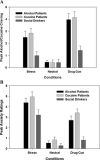Chronic stress, drug use, and vulnerability to addiction
- PMID: 18991954
- PMCID: PMC2732004
- DOI: 10.1196/annals.1441.030
Chronic stress, drug use, and vulnerability to addiction
Abstract
Stress is a well-known risk factor in the development of addiction and in addiction relapse vulnerability. A series of population-based and epidemiological studies have identified specific stressors and individual-level variables that are predictive of substance use and abuse. Preclinical research also shows that stress exposure enhances drug self-administration and reinstates drug seeking in drug-experienced animals. The deleterious effects of early life stress, child maltreatment, and accumulated adversity on alterations in the corticotropin releasing factor and hypothalamic-pituitary-adrenal axis (CRF/HPA), the extrahypothalamic CRF, the autonomic arousal, and the central noradrenergic systems are also presented. The effects of these alterations on the corticostriatal-limbic motivational, learning, and adaptation systems that include mesolimbic dopamine, glutamate, and gamma-amino-butyric acid (GABA) pathways are discussed as the underlying pathophysiology associated with stress-related risk of addiction. The effects of regular and chronic drug use on alterations in these stress and motivational systems are also reviewed, with specific attention to the impact of these adaptations on stress regulation, impulse control, and perpetuation of compulsive drug seeking and relapse susceptibility. Finally, research gaps in furthering our understanding of the association between stress and addiction are presented, with the hope that addressing these unanswered questions will significantly influence new prevention and treatment strategies to address vulnerability to addiction.
Figures


References
-
- Lazarus RS. Stress and Emotion: A New Synthesis. Springer Publishing Company; New York: 1999.
-
- Cohen S, Kessler RC, Gordon LU. Strategies for measuring stress in studies of psychiatric and physical disorders. In: Cohen S, Kessler RC, Gordon LU, editors. Measuring Stress: A Guide for Health and Social Scientists. Oxford University Press; New York: 1995. pp. 3–26.
-
- Levine S. Developmental determinants of sensitivity and resistance to stress. Psychoneuroendocrinology. 2005;30:939–946. - PubMed
-
- Charmandari E, Tsigos C, Chrousos G. Endocrinology of the stress response. Annu. Rev. Physiol. 2005;67:259–284. - PubMed
-
- McEwen BS. Protective and damaging effects of stress mediators: the good and bad sides of the response to stress. Metabolism. 2002;51:2–4. - PubMed
Publication types
MeSH terms
Substances
Grants and funding
LinkOut - more resources
Full Text Sources
Other Literature Sources
Medical

